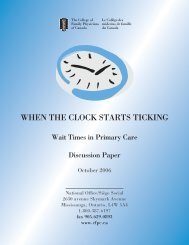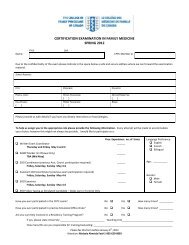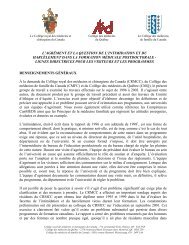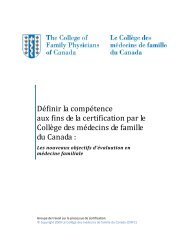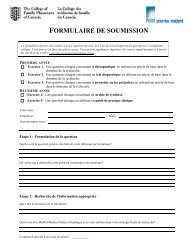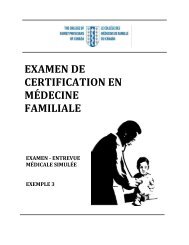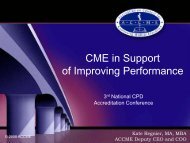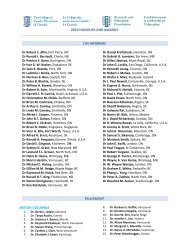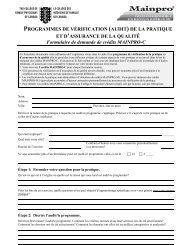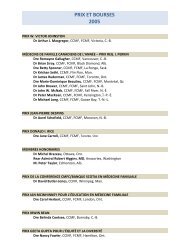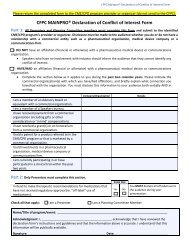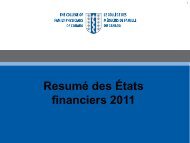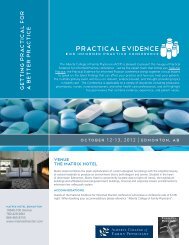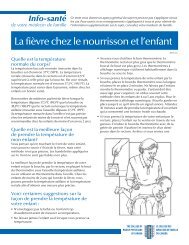Prison Medicine - The College of Family Physicians Canada
Prison Medicine - The College of Family Physicians Canada
Prison Medicine - The College of Family Physicians Canada
Create successful ePaper yourself
Turn your PDF publications into a flip-book with our unique Google optimized e-Paper software.
Version March 12, 2008UBC Department <strong>of</strong> <strong>Family</strong> Practice Post-graduate Residency Program<strong>Prison</strong> <strong>Medicine</strong> Rotation and ElectiveInformation for post-graduate medical residents and undergraduate medicalstudents [referred to as ‘learner’]CONTENTS OF THIS DOCUMENT:A. BackgroundB. <strong>Prison</strong> <strong>Medicine</strong> Curriculum ObjectivesC. Learning ActivitiesD. SecurityE. EvaluationF. <strong>Prison</strong> preceptorsG. APPENDIX 1: Resources, books/serials:H. APPENDIX 2: Contact InformationI. APPENDIX 3: Daily <strong>Prison</strong> Evaluation FormJ. APPENDIX 4: Web-Eval <strong>Prison</strong> Elective Evaluation FormA. BACKGROUNDPeople come into prisons with numerous health issues. <strong>The</strong> incidence <strong>of</strong> diseases, such asHIV, hepatitis C, cervical dysplasia, tuberculosis, psychiatric illnesses, addiction andchronic diseases, are higher in Canadian prisoners than in the general population. <strong>The</strong>prison environment <strong>of</strong>fers further health challenges in the form <strong>of</strong> transmission <strong>of</strong>respiratory infections, new chemical dependencies, transmission <strong>of</strong> blood borne infections,and violence.Incarceration provides enormous opportunities to screen and treat a population at risk.Some people express relief when they are admitted to prison, because they seeincarceration as an opportunity to "get clean" from street drugs, to have a ro<strong>of</strong> over theirhead and to have regular meals. For some, incarceration provides an opportunity to focuson their health; for some, prison may be the only place in their lives where they receivehealth care.By providing post-graduate medicine residents, and undergraduate medicine students [nowreferred to as ‘learner’], with an opportunity to work in prison medical clinics in BritishColumbia, we make real the vision <strong>of</strong> social accountability; that is, we integrate teachingand scholarly enquiry with the medical service <strong>of</strong>fered to a special population.B. PRISON MEDICINE CURRICULUM OBJECTIVESOverall ObjectivesTo provide an understanding <strong>of</strong> people in prison and their health challenges. To raise awareness <strong>of</strong> medical opportunities inside prison to access a high riskpopulationPage 1 <strong>of</strong> 11
Version March 12, 2008To train clinicians who will work with individuals and their current community insideprison and their future community upon release from prison, and will engage them inmeeting these needs (community needs assessment, health status, long term planningetc).To train clinicians who will develop an understanding <strong>of</strong> the health needs <strong>of</strong> peopleinside prison, and who will acquire the skills to address some <strong>of</strong> these health issues.To provide learners with an opportunity to work as part <strong>of</strong> an inter-pr<strong>of</strong>essionalteam in providing health care for a population.To have access to a large Aboriginal population since it is an unfortunatefact that Aboriginal people are over-represented in the Canadian prisonsystem.Personal objectives for this rotation<strong>The</strong> learner should discuss their personal prison medicine objectives with their prisonmedicine faculty supervisor at the beginning <strong>of</strong> their rotation.Rotation Objectives1. <strong>The</strong> family physician is a skilled clinician1.1. To demonstrate an understanding <strong>of</strong> health concerns <strong>of</strong> people in a prisonenvironment, such as:1.1.1. Chemical dependence: tobacco, alcohol, & drugs (prescription and illicit drugs).Learners will become skilled with assessment and management <strong>of</strong> a patient withchronic chemical dependence, withdrawal and methadone prescribing.1.1.2. Violence and abuse (spousal and child abuse, and sexual assault, includingrelated legal obligations). Both are prevalent in the lives <strong>of</strong> the prison inmates,both outside and inside <strong>of</strong> prisons. Learners will gain an understanding <strong>of</strong> theimpact <strong>of</strong> violence and abuse in the lives <strong>of</strong> prisoners1.1.3. Mental health: in particular depression, suicide attempts, management <strong>of</strong>overdoses, prevention, and the psychological effects <strong>of</strong> chemical dependence.1.1.4. Infectious diseases: Tuberculosis, HIV, Viral hepatitis, STDs1.2. To understand prison life, the inter-play <strong>of</strong> addiction and crime, and the barriersand facilitators to the delivery <strong>of</strong> health care to prisoners1.3. Consider the history <strong>of</strong> “non-compliance” with marginalized people in prison, anddevelop skills to invite their participation in their health care1.4. Acquire an understanding <strong>of</strong> traditional perspectives <strong>of</strong> Aboriginal health and therole these may play in attaining health for those Aboriginal people in and out <strong>of</strong>prison.1.5. Acquire an understanding <strong>of</strong> the legal, pr<strong>of</strong>essional and ethical implications forpatients, self and prison staff <strong>of</strong> providing medical care in a correctional setting2. <strong>The</strong> doctor-patient relationship is central to the role <strong>of</strong> the family physicianPage 2 <strong>of</strong> 11
Version March 12, 20082.1. Develop communication competencies involved in respectful dialogue with people inprison.2.2. Recognize the influences <strong>of</strong> family, community (including prison contractors andvolunteers, Aboriginal Elders), and environment on people in prison.2.3. Recognize the disruptive impact <strong>of</strong> colonization on the health and well being <strong>of</strong>Aboriginal people in prison.2.4. Recognize the importance <strong>of</strong> being culturally safe which involves the recognitionthat we are all bearers <strong>of</strong> culture and we need to be aware <strong>of</strong> and challenge unequalpower relations at the individual, family, community and societal level.3. <strong>The</strong> family physician is a resource to a defined practice population3.1. Consider determinants <strong>of</strong> health such as education, unemployment, income, housing,social support, and its relationship to current health status.3.2. Develop skill in working as a member <strong>of</strong> an inter-pr<strong>of</strong>essional team in providinghealth care to prisoners.3.3. Develop communication competencies involved in respectful dialogue regardingmedical knowledge and preventative health care with the prison community (that is,with prison inmates, staff and management)4. <strong>Family</strong> medicine is community based4.1. Recognize the value in taking the time to develop meaningful and trustingrelationships within the prison community and to become an advocate for thecommunity.4.2. Gain an appreciation <strong>of</strong> prison health care initiatives (including health screeningprograms, if available, harm reduction, mental health counseling, rehab services,etc)4.3. Recognize the spectrum <strong>of</strong> care delivery and integrate other resources thatprovide continuity <strong>of</strong> care for the prison community, e.g. public health programs,education and employment retraining programs, healing circles, restorative justice,parole boards, etc.C. LEARNING ACTIVITIES<strong>The</strong> rotation may be structured as a four week block rotation, or as a horizontal rotation(such as, 1 morning/week). Facilities include:• Allouette Correctional Centre for Women, ACCW (women)• Surrey Pre-trial Centre, SPSC (men and women)• Fraser Regional Correctional Centre, FRCC (men)• North Fraser Regional Pre-trial, (men)• Vancouver Jail (men and women)• Burnaby Youth Secure Centre, BYSC (male and female)• Correction Service <strong>Canada</strong>, CSC, in Sumas (Abbotsford) (men and women)Page 3 <strong>of</strong> 11
• Forensic Psychiatric Institute• Regional Treatment CentreVersion March 12, 2008Learners will participate in all aspects <strong>of</strong> health care delivery for prisoners, fromadmission to discharge. Learning activities available to learners include, but are notlimited to nursing admission clinics routine physician clinics psychiatric, and psychologist clinics elder clinics street nurse clinics youth counselors healing circles job training clinics spiritual care <strong>of</strong> inmates, etc.Currently there is no ‘on call’ work for this rotation. However, learners are expected tocreatively find ways to be a resource to the prison community in which they are working.For example, the learner should: <strong>of</strong>fer, design and implement, medical educational workshops for/with prison inmatesand/or prison staff be available to prison nurses for consultation and triage regarding inmate medicalconditionsPrior to the rotation, learners should contact their prison medicine rotation supervisor todiscuss their rotation dates and their personal learning objectives and activities. Learnerswill then contact prison preceptors (See Preceptor Contact information, Appendix B) toorganize an individualized timetable <strong>of</strong> clinics and educational opportunities. Learnersshould discuss their proposed timetable with their prison medicine rotation supervisorprior to the beginning <strong>of</strong> their prison medicine rotation.D. SECURITY1. Most prisons require learners to fill in a security application, to enable a prisonpolice security check. For example, for BC Correctional Centre you will need tosubmit a completed CPIC form to each the centre at least one week before yourrotation commences, as the security check may take several days. Please ask DrMartin to email this form to you.2. Most prisons provide a security awareness orientation for new staff and/orvolunteers. Please ask the prison to provide this orientation for you.E. EVALUATIONPage 4 <strong>of</strong> 11
Version March 12, 2008Learners in a prison medicine rotation will likely work with numerous different prisonclinician preceptors. <strong>The</strong> learner is responsible for inviting every prison clinicianpreceptor, with whom they work, to complete a ‘daily prison evaluation form’ beforethey leave prison each day. (See ‘Daily <strong>Prison</strong> Evaluation Form’, Appendix C). <strong>The</strong> learneris responsible for ensuring the completion and collection <strong>of</strong> all their daily prison evaluationforms. During the initial meeting with the prison medicine rotation supervisor the learnershould book two later appointments with their prison medicine rotation supervisor, one atthe mid-point <strong>of</strong> the prison rotation and one at the end <strong>of</strong> the prison rotation. <strong>The</strong> learnershould bring all their completed daily prison evaluation forms to these two appointments,at which time the resident and their prison medicine rotation supervisor will compile theon-line WebEval mid-point and final prison medicine evaluations (see ‘<strong>Prison</strong> Elective Web-Eval’, Appendix D)F. PRISON PRECEPTORS<strong>Prison</strong> Clinician PreceptorsCaroline Hall, (Physician, Burnaby Youth Secure)Brendan Russell (Physician, Van jail and Surrey Pre-trial)Robert Schlagintweit (Physician, Fraser Regional Centre and North Fraser Pre-trial)Ruth Elwood Martin (Physician, ACCW)Ljiljana Kordic (Physician, ACCW)Paul Beckett (Physician, ACCW and Surrey Pre-trial)Larry Norfeld (Physician, Surrey-Pre-trial)Nader Sharifi (Physician, Forensic Psychiatric Hospital)Linda Healey (Psychiatrist, Regional Treatment Centre)Derek Eaves (Psychiatrist, ACCW and Surrey Pre-trial)Douglas Cave (Psychologist, CSC)Jette Gilbert (Mental Health Coordinator, ACCW)<strong>Prison</strong> <strong>Medicine</strong> Rotation SupervisorsNadir Sharifi (rotation based at Forensic Psychiatric Hospital)Linda Healey (rotation based at Regional Treatment Centre)Ruth Elwood Martin (rotation based in the BC Correctional Centres)<strong>Prison</strong> <strong>Medicine</strong> Residency CoordinatorRuth Elwood Martin; Tel: 604 822 1891; Email: ruth.martin@familymed.ubc.caAny questions? Please do not hesitate to contact Dr Martin.Page 5 <strong>of</strong> 11
G. APPENDIX 1:RESOURCES, BOOKS, SERIALS, PUBLICATIONS:Version March 12, 2008Health in <strong>Prison</strong>s, a WHO guide to the essentials in prison health (2007)http://www.euro.who.int/document/e90174.pdf HHealth in <strong>Prison</strong>s Project, WHO European Office, Webpage resources athttp://www.euro.who.int/prisons (Accessed March 2008)Aboriginal Peoples and the Criminal Justice System. Bulletin. Produced by the CanadianCriminal Justice System. Ottawa: May, 2000. http://home.istar.ca/~ccja/angl/aborit.htmlLocked in, Locked out: imprisoning women in the shrinking and punitive welfare state, byShoshana Pollack, PhD, Wilfred Laurier University, 2008;http://www.wlu.ca/documents/29498/lockedin-final.pdf<strong>The</strong> First Unitarian Congregation <strong>of</strong> Ottawa, <strong>Prison</strong> Support Grouphttp://www.uuottawa.com/prison_group.htm<strong>The</strong> Canadian Justice Association http://canada.justice.gc.ca/en/jus<strong>The</strong> Canadian Association <strong>of</strong> Elizabeth Fry Societieshttp://www.elizabethfry.ca/caefs_e.htm<strong>The</strong> Journal <strong>of</strong> <strong>Prison</strong>ers on <strong>Prison</strong>s http://www.jpp.org/ Check out volume one with itstheme: <strong>Prison</strong>s must be abolished.Human Rights Watch, prison project http://www.hrw.org/advocacy/prisons/monitors.htmDiCenso AM, Dias G, Gahagan J. Unlocking Our Futures: a National Study on Women,<strong>Prison</strong>s, HIV, and Hepatitis C. A report by the <strong>Prison</strong>ers’ HIV/AIDS Support ActionNetwork (PASAN). Toronto: PASAN, 2003. Available athttp://www.pasan.org/Publications/Unlocking_Our_Futures.pdfInfectious Diseases Prevention and Control in Canadian Federal Penitentiaries 2000-01,Correctional Service <strong>Canada</strong>. ISBN JS82-104/2001. Available at http://www.cscscc.gc.ca/text/pblct/infectiousdiseases/index_e.shtmlCollins P, Dias G, Dickenson M, Lines R, Vidovich L. Driving the Point Home: A Strategy forSafer Tattooing in Canadian <strong>Prison</strong>s. A Report by the <strong>Prison</strong>ers’ HIV/AIDS Support ActionPage 6 <strong>of</strong> 11
Network (PASAN). Available athttp://www.pasan.org/Publications/Driving_<strong>The</strong>_Point_Home.pdfVersion March 12, 2008Lines R. Action on HIV/AIDS in <strong>Prison</strong>s: Too Little, too Late- a Report Card. CanadianHIV/AIDS Legal Network, Canadian Strategy on HIV/AIDS. Available athttp://www.aidslaw.ca/Maincontent/issues/prisons/prison_reportcard.pdfJurgens R, et al. ‘HIV/AIDS in <strong>Prison</strong>s’ , Canadian HIV/AIDS Policy & Law Review, Volume8, Number 1, April 2003, pages 49-56. Available athttp://www.aidslaw.ca/Maincontent/otherdocs/Newsletter/vol8no12003/vol8no12003.pdfTuberculosis Prevention and Control in Canadian Federal <strong>Prison</strong>s 1998: reported results <strong>of</strong>the Correctional Service <strong>of</strong> <strong>Canada</strong> Tuberculosis Tracking System. ISBN 0-662-65380-7.Available at http://www.csc-scc.gc.ca/text/pblct/antituberculeuse/reporttoc_e.shtmlRoy M. <strong>The</strong> national drug strategy for the Correctional Service <strong>of</strong> <strong>Canada</strong>. Forum onCorrections research focusing on alcohol and drugs. January 2001, Volume 13, Number 3.Available at http://www.csc-scc.gc.ca/text/pblct/forum/v13n3/v13n3a2e.pdfWichmann C, et al. Women who engage in self-harm: a comparative investigation.Correctional Service <strong>of</strong> <strong>Canada</strong>. February 2002. Available at http://www.cscscc.gc.ca/text/rsrch/reports/r123/r123_e.shtmlDolan K, Rutter S, Wodak AD. <strong>Prison</strong>-based syringe exchange programmes: a review <strong>of</strong>international research and development. Addiction 2003; 98:153-158.Doctors working in prison: human rights and ethical dilemmas, a free on-line course,produced by the Norwegian Medical Association, available on the World MedicalAssociation Webpage. You can browse the course as a guest, or you may take if for credit.http://lupin-nma.net/Joye Morris Health Inc, the health care contractor for BC Provincial CorrectionalCentres at www.jmhs.netPage 7 <strong>of</strong> 11
Version March 12, 2008H. APPENDIX 2CONTACT INFORMATION1. Adult provincial correctional centres, locations and addresses athttp://www.pssg.gov.bc.ca/corrections/contacts/adult_custody/index.htm2. Youth custody information at: http://www.mcf.gov.bc.ca/youth_justice/custody.htm3. Correctional Service <strong>of</strong> <strong>Canada</strong>, Facility Directory, see Pacific Region, http://www.cscscc.gc.ca/text/region/nat_facility_dir_e.shtml#pa34. <strong>The</strong> following clinicians have been, and/or are interested in becoming, prison preceptors Dr Douglas Cave, (Psychologist with CSC), douglascave@shaw.ca Dr. Derek Eaves, (Psychiatrist with ACCW & SPSC), Phone: 604-873-5620 Dr. Carolyn Hall, (Physician at Burnaby Youth Secure), Phone: 604-255-5714,carolynmariehall@yahoo.com Dr. Linda Healy, (Psychiatrist with CSC), Phone:, 604-822-7066, HealeyLM@CSC-SCC.GC.CA Dr. Ruth Elwood Martin, (Physician at ACCW), Phone: 604-822-1891, Fax:, 604-822-6950, ruth.martin@familymed.ubc.ca Dr. Brendan Russell, (Physician at SPSC), Phone: 604-660-2344, Fax: 604-913-1074, erussell@shaw.ca Dr. Robert Schlagintweit, (Physician at FRCC), Phone:, 604-463-4162,Fax: 604-463-3525, rschlagintweit@telus.net Dr Ljiljana Kordic, (Physician at ACCW), Phone: 604 476 2681 Dr Paul Beckett, (Physician at ACCW & SPCC), Phone: 604 476 2681 Jette Gilbert (Mental Health Coordinator at ACCW), Phone 604 476 2681 Dr Nader Sharifi (Physician at Forensic Psychiatric Hospital)nsharifi@forensic.bc.ca ] Tricia Paquette (MOA at ACCW), Phone: 604 476 2681Page 8 <strong>of</strong> 11
Version March 12, 2008I. APPENDIX 3 UBC DEPARTMENT OF FAMILY PRACTICEDAILY PRISON MEDICINE EVALUATION FORMRESIDENT:DATE:Preceptor:To the prison preceptor: Please rate the resident’s performance relative to yourself as a standard, i.e. would youhave done any more or less in the context <strong>of</strong> the problems encountered during today. (S - satisfactory; NI - needsimprovement; E - effective). Please fill in one form at the end <strong>of</strong> every day that the resident works with you.Subjective: History-taking, eliciting appropriate information.Awareness <strong>of</strong> important facts (cues). Problem solving abilities(making appropriate hypothesis).Objective: Skills <strong>of</strong> physical exam; ability to detect obvious signs;appropriateness <strong>of</strong> exam.NI S EAssessment: <strong>The</strong> interaction <strong>of</strong> history and physical findings andrating the urgency <strong>of</strong> the problem.Planning: Appropriate use <strong>of</strong> lab for investigation; therapeuticskills. Use <strong>of</strong> other health personnel; pattern <strong>of</strong> referral.Doctor/Patient Relationship: Empathy, attitude, ethics andinterviewing skills.Efficiency: Organization, termination, use <strong>of</strong> available time.Pr<strong>of</strong>essionalism: interactions with prison inmates, other clinicians& staff; punctuality; demeanour; etc.Nature <strong>of</strong> Patient Problem(s) encountered today:1.Other Comments:Recommendations for improving specific skills:2.Above discussed with resident YesNoPage 9 <strong>of</strong> 11
Version March 12, 2008J. APPENDIX 4: UBC <strong>Family</strong> Practice Residency ProgramResident WebEval Evaluation – <strong>Prison</strong> <strong>Medicine</strong> ElectiveTo be completed by supervisor for this electiveResident: ___________________________________Rotation: <strong>Prison</strong> medicine electiveFaculty Supervisor for this elective______________________Dates on Service: ___________________________________A. Discussion <strong>of</strong> Program Objectives (see: http://www.familypractice.ubc.ca) Date: ______B. Resident’s personal objectives for this rotation: Were they met/completed?1. ________________________________________ ________________________________________2. ________________________________________ ________________________________________3. ________________________________________ ________________________________________4. ________________________________________ ________________________________________C. Mid-Rotation EvaluationDate: ______________________________Comments:D. General Evaluation:CategoryUnabletoJudgeNeedsImprovementAverageAboveAverageExceptionalCommentsA FAMILY PHYSICIAN IS A SKILLEDCLINICIANKnowledge Has knowledge appropriate to level<strong>of</strong> training. Uses knowledge effectively1 2 3 4 5 6 7 8 9 10Assessment Performs appropriatehistory/physician assessment Plans appropriate investigationsProblem Solving Successfully integrates knowledgeand assessmentManagement Creates appropriate managementplanProcedural Skills Pr<strong>of</strong>icient in procedures appropriateto this elective Aware <strong>of</strong> indications andcontraindications for procedures2/3/20122/3/2012 Page 10 <strong>of</strong> 10 11
Version March 12, 2008CategoryUnabletoJudgeNeedsImprovementAverageAboveAverageExceptionalCommentsTHE DOCTOR-PATIENTRELATIONSHIP IS CENTRAL TO THEROLE OF THE FAMILY PHYSICIANPr<strong>of</strong>essionalism Demeanour, Timekeeping, etc.MotivationInterest, initiative, attendanceSelf Awareness Aware <strong>of</strong> limitations Appropriate confidence Functions independently1 2 3 4 5 6 7 8 9 10 Patient Centred Empathises with patient and familyTHE FAMILY PHYSICIAN ISCOMMUNITY BASEDInterpersonal Skills Works effectively with health careteam Interacts effectively with staff andancillary workers Aware <strong>of</strong> community resourcesspecific to this elective1 2 3 4 5 6 7 8 9 10THE FAMILY PHYSICIAN IS ARESOURCE TO A DEFINED PRACTICEPOPULATIONLearning Self directs learning based on patientencounters Presents effective, well researchedrounds/case presentationsE. Rotation-Specific Learning Outcomes:1 2 3 4 5 6 7 8 9 10Has the Resident demonstrated a level <strong>of</strong> competence appropriate to level <strong>of</strong> training?(see program website for rotation –specific learning outcomes)□ Yes □ No □ Unable to AssessGeneral Comments:Overall Evaluation□ Needs Improvement □ Meets Expectations □ Exceeds Expectations(Note: An unsatisfactory evaluation must be discussed with the Resident and the Site Director).□ Pass □ Fail2/3/20122/3/2012 Page 11 <strong>of</strong> 11



